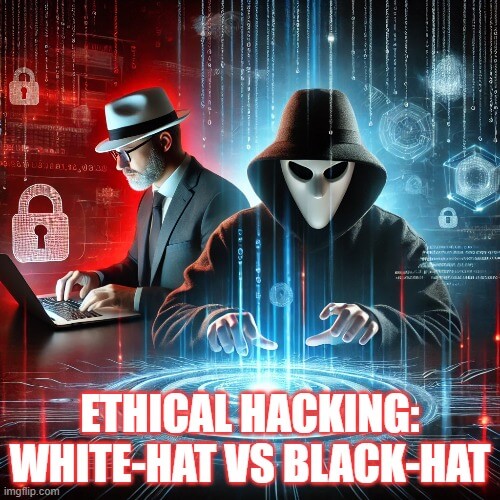In the ever-evolving world of cybersecurity and ethical hacking, hackers play a pivotal role. However, not all hackers are created equal. While some work tirelessly to safeguard systems and protect sensitive data, others exploit vulnerabilities for personal or financial gain. These two contrasting groups are commonly referred to as White-Hat Hackers and Black-Hat Hackers. This blog explores the key differences between them, their roles in the cybersecurity landscape, and why understanding their methods is crucial for businesses and individuals alike.
Table of Contents
Who Are White-Hat Hackers?

White-hat hackers, also known as ethical hackers, are cybersecurity professionals who use their skills to identify and fix vulnerabilities in computer systems, networks, and applications. They operate within legal boundaries and often work with organizations to strengthen their security posture.
Characteristics of White-Hat Hackers:
Authorization: They operate with the explicit consent of the system owner.
Ethical Intentions: Their primary goal is to protect and secure systems.
Professional Roles: Many work as penetration testers, security consultants, or IT auditors.
Tools and Techniques: They use tools like Metasploit, Nmap, and Burp Suite to simulate cyberattacks and test defenses.
Certifications: Many white-hat hackers hold certifications such as CEH (Certified Ethical Hacker), OSCP (Offensive Security Certified Professional), or CISSP (Certified Information Systems Security Professional).
The Role of White-Hat Hackers:
White-hat hackers are often employed to conduct penetration testing and vulnerability assessments. Their work helps:
Prevent data breaches.
Ensure compliance with security standards.
Educate organizations about potential risks.
Who Are Black-Hat Hackers?

Black-hat hackers, on the other hand, are individuals who exploit system vulnerabilities for malicious purposes. Their actions are illegal and often result in significant financial, reputational, or operational damage to their targets.
Characteristics of Black-Hat Hackers:
Unauthorized Access: They gain access to systems without permission.
Malicious Intentions: Their goals may include stealing data, spreading malware, or causing disruption.
Criminal Activities: Many engage in identity theft, ransomware attacks, or financial fraud.
Tools and Techniques: They use similar tools as white-hat hackers but for malicious purposes. Popular tools include Kali Linux, phishing kits, and keyloggers.
Motivations of Black-Hat Hackers:
Financial Gain: Through ransomware, credit card theft, or selling stolen data.
Espionage: State-sponsored hackers often target governments or corporations.
Notoriety: Some seek recognition within hacker communities.
Vandalism: Causing chaos or disrupting services for personal satisfaction.
Key Differences Between White-Hat and Black-Hat Hackers
| Aspect | White-Hat Hackers | Black-Hat Hackers |
|---|---|---|
| Legal Status | Operate within the law and with consent | Act illegally without authorization |
| Intent | Protect systems and users | Exploit systems for malicious purposes |
| Employment | Work for organizations, governments, or as freelancers | Operate independently or in hacker groups |
| Methods | Follow ethical guidelines and legal frameworks | Use deceptive and harmful techniques |
| Outcome | Strengthen cybersecurity | Cause financial, reputational, or operational damage |
Overlap: The Grey-Hat Hackers
While white-hat and black-hat hackers represent two extremes, there is a middle ground: grey-hat hackers. Grey-hat hackers operate in a legal and ethical gray area. They often:
Discover vulnerabilities without authorization.
Report issues to organizations, sometimes expecting a reward.
Use their skills for good intentions but without following proper procedures.
For instance, a grey-hat hacker might find a flaw in a company’s website and inform the company without prior consent. Though their intentions may be good, their actions could still be considered illegal.
Why Understanding the Difference Matters
For businesses and individuals, distinguishing between white-hat and black-hat hackers is crucial to:
Develop Effective Defenses: Knowing how black-hat hackers operate helps organizations anticipate and prevent attacks.
Promote Ethical Hacking: Supporting white-hat hackers through bug bounty programs or hiring penetration testers can significantly enhance security.
Stay Informed: Awareness of cybersecurity threats empowers users to take proactive measures, such as using strong passwords and updating software regularly.
How to Support White-Hat Efforts
Invest in Cybersecurity: Allocate resources to hire ethical hackers and conduct regular security audits.
Encourage Bug Bounty Programs: Provide incentives for ethical hackers to report vulnerabilities.
Educate Employees: Train staff to recognize phishing attempts and other cyber threats.
Adopt Strong Security Protocols: Implement multi-factor authentication, encryption, and endpoint protection.
Why Businesses Trust SecureMyOrg for Comprehensive Network Security
At SecureMyOrg, we uncover and fix all possible security vulnerabilities of mobile and web, while providing solutions to mitigate risks. We are trusted by renowned companies like Yahoo, Gojek and Rippling, and with 100% client satisfaction, you’re in safe hands!







Some of the things people reach out to us for –
- Building their cybersecurity program from scratch – setting up cloud security using cost-effective tools, SIEM for alert monitoring, building policies for the company
- Vulnerability Assessment and Penetration Testing ( VAPT ) – We have certified professionals, with certifications like OSCP, CREST – CPSA & CRT, CKA and CKS
- DevSecOps consulting
- Red Teaming activity
- Regular security audits, before product release
- Full time security engineers.
Conclusion
White-hat hackers and black-hat hackers represent two sides of the cybersecurity coin. While white-hat hackers strive to protect and defend, black-hat hackers exploit and disrupt. Understanding their roles, methods, and motivations is essential in the fight against cybercrime. By supporting ethical hacking efforts and investing in robust cybersecurity measures, organizations can stay one step ahead of malicious actors and build a safer digital world.
Relevant Posts
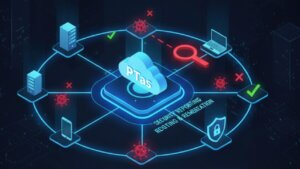
What Is Penetration Testing as a Service?
Penetration testing as a service (PTaaS) lets experts simulate real attacks to uncover vulnerabilities before hackers do. This guide explains the process, benefits, and costs, helping businesses strengthen defenses with predictable, ongoing security checks.
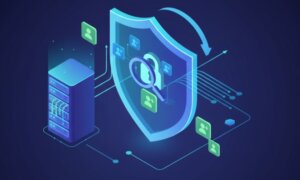
How To Inspect Encrypted Traffic Without Breaking Privacy
Network administrators face a challenge: securing systems while respecting privacy. This guide explains how to inspect encrypted traffic without breaking privacy using metadata, anomaly detection, and machine learning ensuring visibility, compliance, and trust.

How to Audit Infrastructure as Code (IaC) for Security Vulnerabilities
Discover how to audit Infrastructure as Code (IaC) for security vulnerabilities with this practical guide. Learn to scan IaC files using tools like Checkov, fix issues like exposed resources, and integrate audits into CI/CD pipelines. Protect your cloud systems from misconfigurations and ensure compliance with clear, actionable steps.
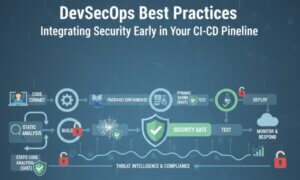
DevSecOps Best Practices: Integrating Security Early in Your CI/CD Pipeline
This article provides a practical guide to embedding security into every stage of your CI/CD pipeline. Learn core DevSecOps best practices like SAST, DAST, dependency scanning, secrets management, and compliance automation to catch vulnerabilities early, foster a culture of shared ownership, and build a secure-by-design development process that accelerates release cycles.

5 Cloud Misconfigurations That Lead to Data Breaches
Cloud misconfigurations are one of the leading causes of data breaches, yet they’re also among the most preventable. From exposed storage buckets to weak IAM policies, attackers exploit these mistakes daily. Learn about the top 5 misconfigurations and how your organization can fix them before they lead to costly data exposure.
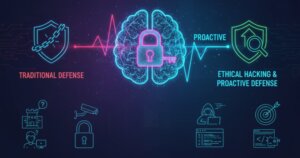
How Can Ethical Hacking Training Elevate Your Internal Cybersecurity?
Ethical hacking training empowers organizations to strengthen internal cybersecurity by uncovering vulnerabilities before attackers do. From mastering penetration testing to enhancing incident response, this training builds a proactive security culture. Learn how Secure My ORG’s programs can elevate your team’s skills and fortify defenses against modern threats like AI-driven attacks.
